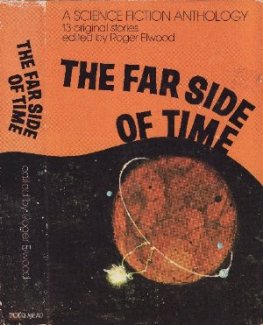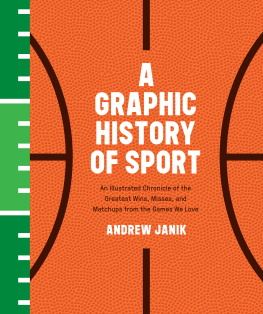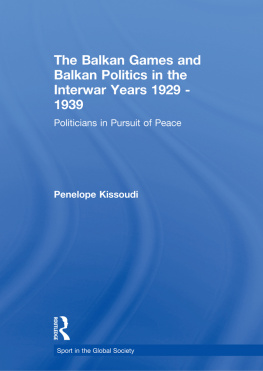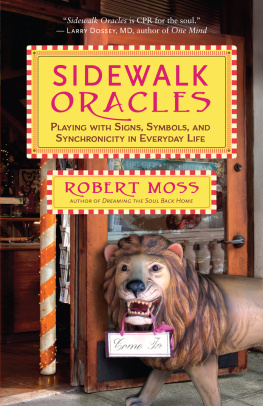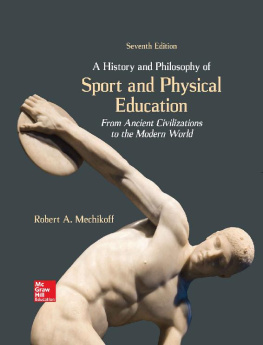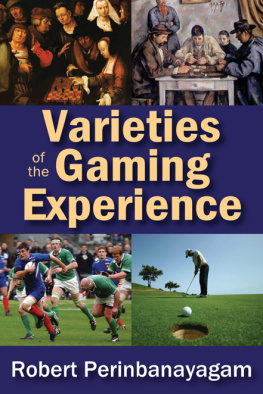First published 2006 by Paradigm Publishers
Published 2016 by Routledge
2 Park Square, Milton Park, Abingdon, Oxon OX14 4RN
711 Third Avenue, New York, NY 10017, USA
Routledge is an imprint of the Taylor & Francis Group, an informa business
Copyright 2006, Taylor & Francis.
All rights reserved. No part of this book may be reprinted or reproduced or utilised in any form or by any electronic, mechanical, or other means, now known or hereafter invented, including photocopying and recording, or in any information storage or retrieval system, without permission in writing from the publishers.
Notice:
Product or corporate names may be trademarks or registered trademarks, and are used only for identification and explanation without intent to infringe.
Library of Congress Cataloging-in-Publication Data
Perinbanayagam, R. S. , 1934
Games and sport in everyday life : dialogues and narratives of the self / Robert Perinbanayagam.
p. cm.
Includes bibliographical references and index.
ISBN 1-59451-108-X
1. Game theory. 2. Political scienceMathematical models. I.
Title.
JA72.5. P38 2006
300.15193dc22
2005033051
ISBN 13 : 978-1-59451-108-0 (hbk)
ISBN 13 : 978-1-59451-109-7 (pbk)
Designed and Typeset by Straight Creek Bookmakers.
Games in general have been studied from a variety of perspectives. They have been studied as forms of activity, as spectacles, as institutions in which class, gender, and race are represented in one way or another, and as instruments for cultural transformation and political domination. Rarely have they been studied as a form of activity that a social agent undertakes in order to interact with an other and construct a system that has meaning to him or her. Games are, after all, played more often by ordinary people in their everyday lives, with little concern for spectators, and played without being paid to do so. Games are not only played voluntarily but are also undertaken by an agent in charge, generally speaking, of all the moves in the game. Games, if played with commitment and dedication, provide a sense of adventure, situate such playing within strictly enforced norms and codes of conduct, and give a modicum of power to the player, to put Simmel, Durkheim, and Marx together into a unified argument. Games become an efficient means of finding surcease from boredom, anomie, and alienation.
Einstein in a famous response to certain implications of quantum theory remarked, god does not play dice with the universe. In Hindu myth, however, the supreme god Siva does play dice with his consort Parvati and the playing is said to be about time and the universe. In the various myths of Siva and in saivite iconography he is represented as playing dice. The dice that Siva and Parvati use, too, are special ones: each side is said to represent a yuga, a measurement of time usually translated as aeons. Each throw of the dice then represents both the creation of time as well as its fundamental uncertainty: once the dice are thrown the god cannotor does not choose tocontrol the unfolding of a temporality. It is truly uncertain and indeterminate and depends on the responses the dice are able to mobilize from the universe of objects they will encounter as they fall. Further, in the mythology of Siva, he is always made to lose the game to his consort. Here then we have an omnipotent and omniscient as well as self-generated god playing dice with Parvati, who herself was created by Siva, managing to lose the game on a continuous basis. One question that arises is why did the myth makers of antiquity create an omnipotent god and then make him lose the dice games to his consort?
There are many theological and philosophical answers to this puzzlemany of them examined brilliantly by Handelman and Shulman (1997)but one can nevertheless inquire about the structural and social psychological implications of this arrangement. It seems to me that the mythmakers understood that even omnipotent gods cannot be left alone and isolated. They too need to play, be in the game, and interact with other people. Siva then is made to play dice with his consort and is not allowed to resort to his powers to win. If he is allowed to use his supreme authority to win against Parvati, then there will be no game and no reason for her to play again but an omnipotent god can afford to lose and still want to play insofar as it gives him Parvatis companionship and favors. To make the god lose enables the game to be continued and such interaction as does occur creates various ongoing consequences. Every time Parvati wins the game, the gate is open for conversations: she teases him and cajoles him, demands the payment of his gambling debts, and angers him and later pleases him too. The game then is able to ensure continuous interactions as well as both cognitive and emotional engagement between the two players.
The myths of the god who plays dice enable the confrontation with a number of intellectual problems: Siva, the self-created god, answers the puzzle of the first cause. Once that problem is solved, another is faced: he will need action, movement, and above all interaction. Once Parvati enters the scene, they must have something that they can do together. And insofar as he is god and she is his consort, whatever they do together must have some cosmic significance: so they play with time and the universe, creating and destroying them in ongoing cycles.
This myth captures two of the fundamental features of games: its imbrication with the processes of time and its irrefutably dialogic character. In everyday life, too, as agents play games, they are, in fact, playing with time, their own awareness of the past and the present, and their anticipation of a future that is hoisted on the turn of the dice or the distribution of cards or the movements of a ball that has been hit or driven or thrown or kicked.
Game playing is a structure of activity in which already constituted selves are given play and in which new elements of selves are constructed while old elements are reconstituted or discarded. Insofar as the constitution of selves is an ongoing activitywith the self as both object and subject, constituted and constitutinggames, when they occur, are sites and situations in which such constituting activities go on. Such activity is relatively free from the domination and the control of agents that are present in many other arenas of social life. The absence of such domination and control in ordinary game playing provides opportunities for human agents to escape from alienation and seek to achieve some level of creative freedom.
Such freedom is, however, achieved within given structures. These structures both enable and guide these moves of creative action. The structures representing distilled and encapsulated versions of the problems of everyday life have the quality of myths not only in the sense of narratives that have an immutable structure that speaks to certain eternal problems faced by members of the human species, but also as narratives that incorporate current historically specific concerns into their manifestations. In fact, games are myths enacted and performed in situ, in contrast to other myths that are either recounted or performed on stage by actors. Games are narratives, as myths are, but in playing games an agent puts his or her self into play with these narrative structures. Acts, temporality, and emotionality are unified into one process. In these enacted myths, each participant is given the bare structure of the myth which he or she has to use to give play to his or her self while at the same time constructing and reconstructing a self. In putting oneself into the structures of various games, an agent will play hard and play with commitment and work toward a denouement without knowing the denouement in advance. The resolution, in fact, is achieved by the contingent interactions of various forces brought into play by the various players.




